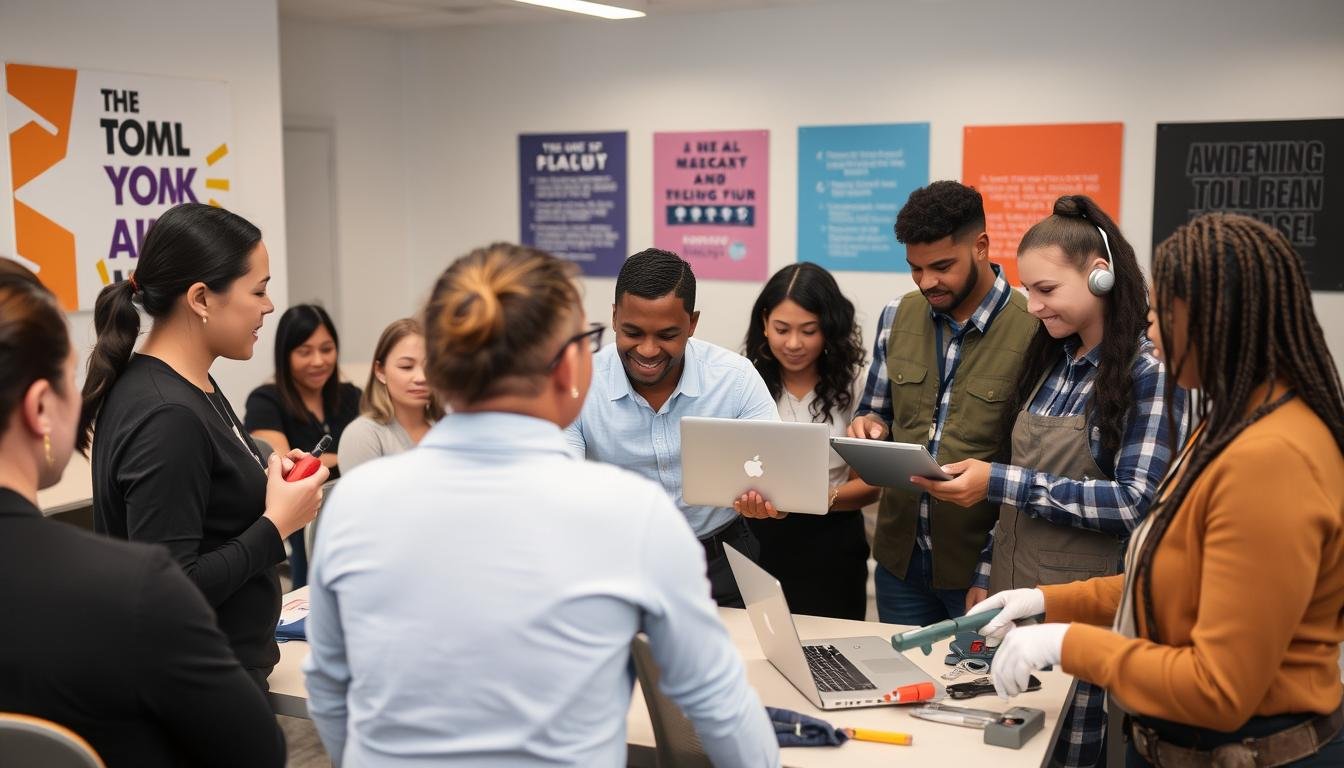Enhancing Workforce Skills: A Guide to Success
Are you ready to unlock your team’s full potential? In today’s fast-paced business world, having the right skills is key. But, there’s a gap between what companies need and what employees can do. Let’s explore how improving workforce skills can change your business for the better.
Imagine this: 89% of those in learning and development think it’s vital to build employee skills for the future. But, only 26% of workers feel they have the chance to learn new skills at work. This gap shows a big missed chance for growth and new ideas.
Training employees isn’t just about checking off tasks. It’s about making a team that’s involved, productive, and ready for anything. Companies with highly engaged teams are 21% more profitable than others. This is good for business and everyone working there.
From getting better at digital skills to improving problem-solving, professional growth never stops. It’s about giving your team the tools they need to handle today’s and tomorrow’s challenges. Are you ready to start this journey?
Key Takeaways
- Workforce skills development is crucial for business success
- There’s a significant gap between skill needs and current training
- High employee engagement leads to increased profitability
- Continuous learning is essential in today’s dynamic work environment
- Professional development enhances job satisfaction and career growth
- Effective skill enhancement requires a strategic, ongoing approach
The Importance of Workforce Skills in Today’s Business Landscape
In today’s fast-changing business world, having the right skills is key to success. Companies are now focusing more on skills than traditional job titles. This change is because of new technology and how work is changing.
Addressing the Skills Gap
A Deloitte survey shows that companies are trying new ways to work. They’re breaking jobs into smaller tasks and moving to a skills-based model. But, only about 20% of companies have fully switched to this new approach. This shows we need to pay more attention to analyzing skills gaps and mapping competencies.
Impact on Business Performance
Investing in employee skills really helps a business do better. Trained workers are more productive and creative. In fact, 77% of business leaders think being able to move skills around is key to handling future changes. This shows how important it is to have upskilling programs to stay competitive.
Employee Satisfaction and Retention
Putting a focus on skill development makes employees happier and more likely to stay. A big 79% of business leaders think companies should focus on making workers’ lives better. This approach is changing how we work and shows how important ongoing learning is.
| Aspect | Percentage | Impact |
|---|---|---|
| Skills-based decision making | 80% | Reduces bias in hiring, promotions, and pay |
| Anticipated talent shortages | 73% | Drives creative skill sourcing |
| Technology as driver for skills-based approach | 61% | Influences workforce strategies |
As companies adapt to these changes, focusing on upskilling, analyzing skills gaps, and mapping competencies is crucial. It’s key for success and growth in the long run.
Identifying In-Demand Workforce Skills
The job market is changing fast, with new skills needed all the time. LinkedIn reports that last year, people added 680 million skills to their profiles, an 80% jump from before. By 2030, 65% of job skills will likely change, showing the importance of learning new things.
Communication and Collaboration
Communication is the top skill needed for 2024, says LinkedIn. Working well with others is key as teams change how they work together. These skills help with moving up in your career and being ready for the workplace today.
Problem-Solving and Critical Thinking
With AI around, solving problems is more important than ever. Critical thinking helps workers tackle new challenges smartly. Strategic thinking is the most wanted soft skill for high-paying jobs, appearing in 65% of job ads for these roles.
Digital Literacy and Technology Proficiency
The cloud computing market is set to hit $591.8 billion in 2023, making digital skills key. But, 73% of workers worldwide feel they lack the digital skills needed by businesses. This shows how vital training in technology is.
Adaptability and Continuous Learning
Being adaptable is now the most in-demand skill, showing a big increase in demand. The fast pace of change means we must keep learning. This is why professional certificates are getting more popular, with employers 72% more likely to hire those with them.
“The ability to learn is the most important quality a leader can have.”
As the business world changes, these skills are key for being ready at work and moving up in your career. Both companies and individuals need to focus on learning and growing to keep up in this fast-changing world.
Strategies for Developing Workforce Skills
In today’s fast-changing business world, it’s key to develop workforce skills for success. Companies now focus more on skills than degrees. They see the need for a workforce that can adapt and excel.
Upskilling programs are a great way to go. They help employees learn new skills and improve the ones they already have. This keeps them up to date in their jobs. These programs can include training at work, workshops, and online courses that match job needs.
Competency mapping is also important for workforce growth. It’s about finding out what skills and knowledge each job needs. By doing this, companies can see where skills are lacking. Then, they can make training plans to fill those gaps.
Career pathing is key to helping employees grow and move up in a company. It shows them where they can go in their careers. This makes employees happier and more likely to stay with the company. It also helps keep the best people from leaving.
- Conduct regular skills assessments
- Create personalized development plans
- Offer mentorship and coaching programs
- Provide opportunities for cross-functional training
“Investing in workforce development is a valuable move for human resources teams to support employee growth and enhance organizational value.”
By using these strategies, companies can build a workforce that’s skilled, engaged, and ready for the future. Those that focus on workforce development can draw in the best talent. They can keep their employees and drive new ideas in their fields.
Implementing Effective Training and Development Programs
Employee training and professional development are key to business success. Companies are now using many learning strategies to boost skills. Let’s look at some effective ways to do this.
On-the-Job Training
On-the-job training is still a top choice for skill growth. It lets employees learn by doing, improving their real-world skills. Thanks to e-learning platforms, this process is now more flexible. CYPHER Learning supports over 50 languages, helping a global workforce.
Bootcamps and Intensive Workshops
Bootcamps provide deep learning experiences. These programs can quickly improve skills in certain areas. For example, Absorb’s Generative AI feature offers advanced training for companies and mid-market needs.
Certification Programs
Certification programs prove a person’s skill level in certain areas. LearnWorlds offers a 30-day free trial for ongoing training programs, working with over 10 payment methods. This helps solve the 50% of recruitment issues due to career growth expectations.
Mentorship and Coaching
Mentorship programs, like Panda Restaurant Group’s University of Panda, help keep millennial employees. Such programs make 87% of employees at Fortune 100 Best Companies feel they have the tools for growth. Good training not only boosts skills but also shapes a positive company culture. It also improves customer interaction and ensures legal and ethical standards.
Source Links
- 7 Skills to Enhance Your Job Performance | HBS Online
- Skills for Success | Working at Cornell
- The skills-based organization: A new operating model for work and the workforce
- How Workplace Learning is Evolving – Innovation in Business
- The Most In-Demand Skills of 2024 | LinkedIn
- The Top 10 In-Demand Soft Skills To Learn In 2024, Based On Research
- The Fastest-Growing Job Skills of 2024 Report – Coursera Blog
- Taking a skills-based approach to building the future workforce
- 6 Workforce Development Strategies to Build Agile, Resilient Teams
- Workforce Development Strategies
- What Is Employee Training? Definition & Best Practices
- Employee Training and Development: The Benefits of Upskilling or Reskilling Your Team







